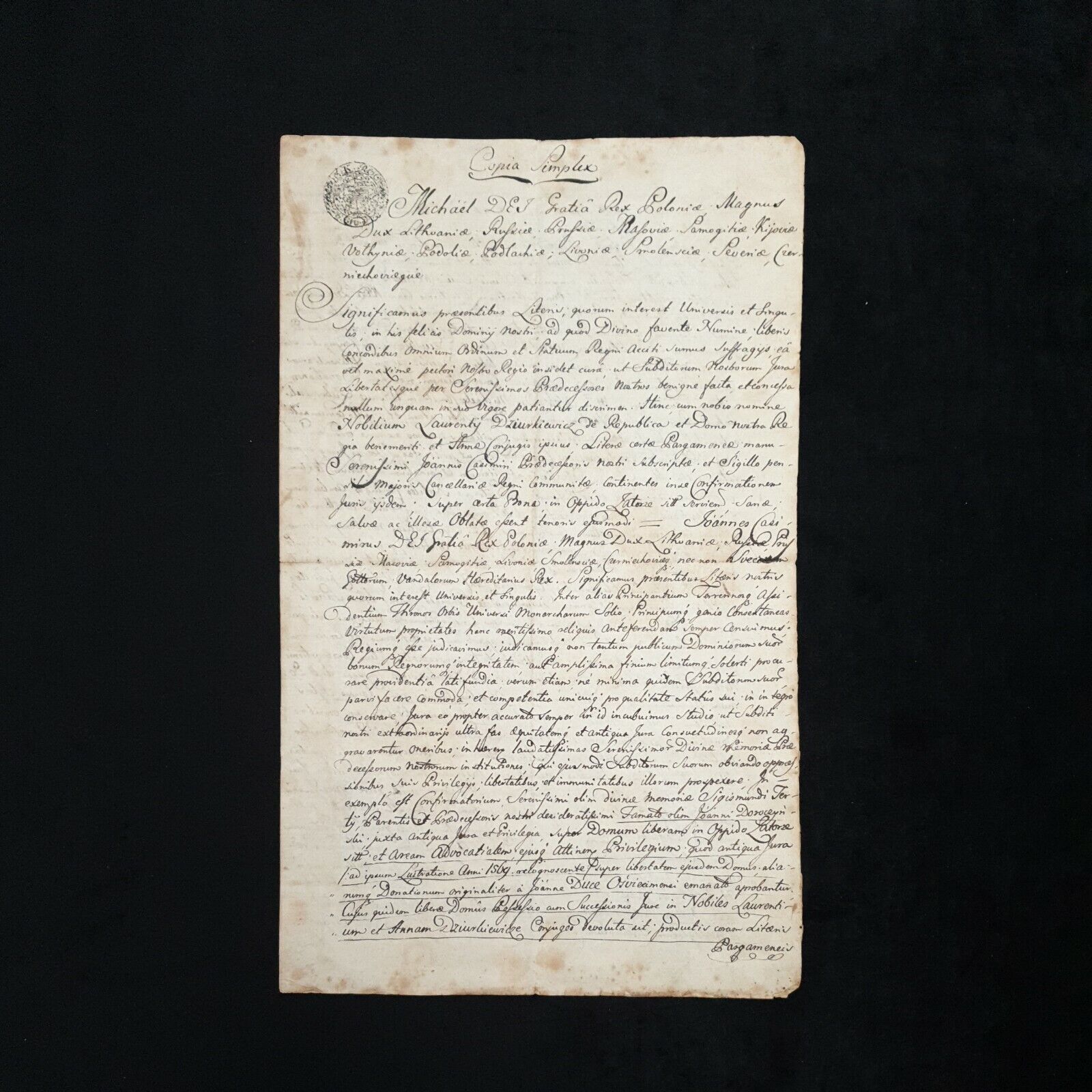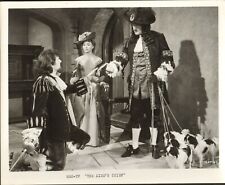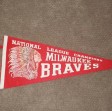When you click on links to various merchants on this site and make a purchase, this can result in this site earning a commission. Affiliate programs and affiliations include, but are not limited to, the eBay Partner Network.
LOT-Y32. For your consideration is an exceedingly rare and historically important c.1669 King Michael I of Poland Royal Manuscript Document / Decree of his Lifetime achievements. Official royalty decree order. This museum quality manuscript consists of 4 handwritten pages on a single folio. Condition is original. Paper type is laid. This royal manuscript letter is handwritten on royal stationary / letterhead with a watermark of the Royal Polish Imperial Eagle. A very scarace piece of Polish / Poland history. This authentic document measures approximately 16.5\" x 14.0\". Guaranteed correct and original. Discoloration to paper, as pictured. Official royal Polish / Poland stamp in ink at top upper left-hand corner.
Michael I(Polish:Michał Korybut Wiśniowiecki,Lithuanian:Mykolas I Kaributas Višnioveckis; 31 May 1640 – 10 November 1673) was the ruler of thePolish–Lithuanian CommonwealthasKing of PolandandGrand Duke of Lithuaniafrom 29 September 1669 until his death in 1673.
Chosen partly because of the merit of his father, princeJeremi Wiśniowiecki, a powerful bordermagnatewho had helped suppress theCossacksin easternPolandduring theKhmelnytsky Uprising. After Michael\'s early death, these setbacks were reversed at theBattle of Khotynin 1673 by his successor, John III Sobieski, who defeated an Austrian candidate in the election.
In 1670 Michael I was married toEleonora Maria of Austria(1653–1697), daughter ofFerdinand III, Holy Roman Emperor, by his third wifeEleonora Gonzaga.
Michael was the son ofJeremi Wiśniowieckiand his wifeGryzelda Konstancja Zamoyska. His parents likely met each other in September 1637 in Warsaw during the crowning ofCecilia Renata of Austria, theQueen of Polandand consort toWładysław IV. They were engaged on 13 February 1638, over a month after the death of Gryzelda’s father,Tomasz Zamoyski.
The wedding took place inZamośćon 27 February 1639, and over a year later, on 31 May 1640, Michael Korybut was most likely born in the village ofBiały Kamieńas Michał Tomasz Wiśniowiecki. The infant was then taken to Zamość, where he spent first two years of his life under care of his grandmother Katarzyna Zamoyska (née Ostrogska). In 1642, Michał was taken by his mother toLubny. During theKhmelnytsky Uprising, he fledLeft-bank Ukrainewith his family and first settled inWiśniowiecinVolhynia, before arriving in Zamość in autumn 1648.
Jeremi Wiśniowiecki died in 1651, when most of his enormous estate remained under Cossack or Russian control. From 1651 – 1655, young Michał was under the care ofKarol Ferdynand Vasa, the bishop ofWrocławandPłock. The boy stayed at the residence of the Bishops of Płock, in the town ofBrok. After the death of Bishop Vasa on 9 May 1655, he was taken in by his wealthy uncle,Jan Zamoyski,VoivodeofSandomierz, who funded his education. Sometime in mid-1655, Michał found himself at the court of KingJohn II Casimir.
Following theSwedish invasion of Poland, Michael, together with the royal court, fled toGłogówekinUpper Silesia. On 18 November 1655, following the request of the king, he went toNysa, to study at the Jesuit College Carolinum and stayed there until March 1656.
In mid-1656, thanks to the support of QueenMarie Louise Gonzaga, Michał Korybut began studying atCharles University in Prague. He returned to Poland in June 1660, but soon afterwards, headed toDresdenandViennato meet EmpressEleonora Gonzaga. There he saw his future wifeEleanor of Austria, who was a child at that time, for the first time. On this trip, Michael improved his knowledge of languages; he spoke Latin, German, Italian, French and also likely Tatar and Turkish as well.
In 1663, Michel took part in theRusso-Polish War, and during theLubomirski Rebellion, he loyally supported the king.
On 16 September 1668,John II Casimirabdicated the Polish throne and left the country to live inFrance, making a newelectionnecessary. The Bishop ofChełmno, Andrzej Olszowski, suggested that Michał Korybut should be listed as one of candidates for the throne. Wiśniowiecki was supported by thePolish nobility, who sensed that a poor and inexperienced prince would not pose a threat to their rights enshrined in theGolden Liberty.
TheFree election of 1669took place in May and June of that year. Michał Korybut Wiśniowiecki was elected King of Poland and Grand Duke of Lithuania on 19 June and became known as Michael I. Most of the gathered nobility voted for him as they wished to choose a native, Polish candidate (the so-called \"Piast\"), over foreign candidates. Wiśniowiecki won 11,271 votes and was crowned on 29 September 1669 inKraków.
His election was immediately opposed by the pro-French camp, led byPrimate of PolandMikołaj Prazmowski and CrownHetmanJohn Sobieski.
On 27 February 1670 Michael I married Austrian princessEleanor, and the ceremony was celebrated by Papal Nuncio, CardinalGaleazzo Marescotti, as Primate Prazmowski refused to attend. The reception took place at the Denhoff Palace inKruszyna.
Following the 1669 election, the Commonwealth was divided between two camps – pro-French, and royal. The pro-French camp had several influential members, including Primate Prazmowski, Hetman Sobieski,Andrzej Morsztyn, Voivode of KrakówAleksander Michał Lubomirski, Voivode ofRutheniaStanisław Jan Jabłonowski, Voivode ofPoznańKrzysztof Grzymultowski, and Bishop of KrakówAndrzej Trzebicki.
In November 1669, the French camp broke the CoronationSejm, hoping to dethrone Michael and elect Count Charles-Paris d\'Orléans-Longueville. In 1670, the internal struggle moved to the localsejmiks, during which the nobility demanded to bring a Sejm lawsuit against Hetman Sobieski. To defend their commander, Sobieski\'s soldiers formed aConfederationnearTrembowla.
To make matters worse, the divided Commonwealth was under constant Turkish threat. In 1671, the king supported a rebellion of a unit of Stanisław Wyżycki, who, against the explicit order of Sobieski, abandoned Volhynia, leaving the province defenceless. King Michael ordered Wyżycki and his men to spend the winter of 1671/72 in the wealthystarostwoofSambor, and paid them their salaries, while Sobieski and his soldiers did not receive any money.
In 1672, the Ottoman Empire declared war on the Commonwealth, and thePolish–Ottoman War of 1672–76began. Despite this, the situation in the Polish Crown was still chaotic, with the danger of a civil war. The nobility formed a confederation nearGołąb, demanding the removal of Primate Prazmowski. Its members looted real estate owned by Hetman Sobieski and his family. On 22 November 1672 Lithuanian soldiers formed their own confederation inKobryń, declaring their support for the Gołąb confederation. In response, soldiers under Sobieski formed a confederation inSzczebrzeszyn. John Sobieski, together with his troops, headed toŁowicz, to meet Primate Prazmowski.
Negotiations between the two factions were carried out by Papal Nuncio Francesco Buonvisi and Bishop of KrakówAndrzej Trzebicki. Furthermore, SultanMehmed IVof the Ottoman Empire sent an offensive letter to Warsaw, demanding complete subordination of the Commonwealth. This greatly enraged the Poles but due to chaotic internal situation of the Commonwealth, both sides of the conflict reached an agreement in March 1672.
In June 1672, a 100,000-strong Ottoman army, under Mehmed IV, besieged the city ofKamieniec Podolski, which capitulated after 26 days. The invaders then approachedLwów, which paid a ransom. MountedCrimean Tatarunits penetrated as far asHrubieszów,JasłoandBiecz.
In October 1672, Hetman John Sobieski, upon request of the senators, tried to stop the invaders, defeating them in theBattle of Niemirów,Battle of Komarno, and Battle of Petranka. Meanwhile, theTreaty of Buchachwas signed on 18 October, in which the king cededPodoliato the Ottomans and agreed to pay a yearly tribute. Under these terms, the once mightyPolish-Lithuanian Commonwealthwas humbled by the Turks.
Soon afterwards, Michael I began preparation for a new military campaign against the Ottomans. On 8 October 1673 at Skwarzawa nearZłoczów, some 40,000 Polish soldiers concentrated, with 50 cannons. Due to poor health, the king handed the command of the army to Sobieski, and the Poles marched southwards, toChocim.
King Michael I Korybut died in the Palace of the Archbishops of Lwów, on 10 November 1673. His early demise seems to have been brought about by a severe case of food poisoning, although rumours persisted that he had been actually murdered by traitorous generals angered at the declining power of the Commonwealth.
The day after his death, John Sobieski won theBattle of Chocim, which reversed some of the losses under Michael I\'s reign. On 19 May 1674 Hetman John Sobieski was elected the new monarch after theFree election of 1674.
After the funeral, the heart of the king was buried at a Camedule Monastery in theBielanydistrict of Warsaw. The bowels were placed in a wall of theLatin Cathedralin Lwów, while the body was buried inWawel Cathedralin Kraków on 31 January 1676, the same day that John Sobieski was crowned as John III.
Michael\'s reign was considered to be less than successful as his ability to be a capable monarch were greatly hurt by Poland\'s quarrelling factions. His father\'s military fame notwithstanding, Michael lost the first phase of thePolish–Ottoman War of 1672–1676.










